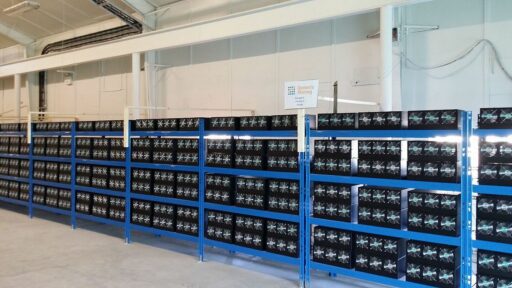The world of cryptocurrency mining is a complex and ever-evolving landscape, with miners constantly seeking to balance the cost of their operations against potential profits. This article delves into the multifaceted aspects of crypto mining, drawing insights from Reddit discussions to explore the financial viability, technological advancements, environmental impact, security and maintenance, and regulatory and privacy considerations. Whether you’re a seasoned miner or new to the scene, understanding these dynamics is crucial for navigating the crypto mining terrain.
Key Takeaways
- Crypto mining profitability is influenced by market trends, electricity and hardware costs, and requires continuous monitoring and adjustment.
- Technological advancements, such as the Antminer S19 XP and its successors, necessitate staying informed about firmware updates and performance optimization.
- Environmental concerns are driving innovations in sustainable mining practices, with a focus on lowering the carbon footprint and utilizing renewable energy.
- Maintaining mining hardware is vital for operational longevity, involving best practices for ASIC repair, ESD safety, and routine troubleshooting.
- Regulatory changes and privacy issues, including OP_CTV (BIP 119) and non-KYC Bitcoin, are significant factors for miners to consider and adapt to.
The Financial Viability of Crypto Mining

Assessing the Profitability of Mining Ventures
The profitability of crypto mining ventures hinges on a delicate balance between operational costs and the revenue generated from mined cryptocurrencies. Efficiency is paramount, as it directly impacts profitability. Here are strategies to maximize both:
- Monitoring and adjusting mining settings regularly
- Staying informed about the latest industry trends
- Implementing surge protection for electrical setups
The journey to maximize mining profits extends beyond the physical setup. It involves continuous performance monitoring and adaptation to new technologies and market dynamics.
A Monero-mining revenue calculation tool highlighted the importance of scale in profitability. For instance, with a Monero price of $202.43, the estimated earnings in 24 hours would be approximately $15.85, excluding electricity costs. However, if the mining operation only runs for 4 hours, the revenue drops to $2.64, emphasizing the need for sustained mining operations to achieve profitability.
| Cost Item | Estimated Expense |
|---|---|
| Electricity | Variable (local rates) |
| Hardware | Initial investment cost |
| Maintenance | Periodic expenses |
Understanding these financial aspects is crucial for miners who aim to optimize their operations and ensure long-term success in the competitive landscape of cryptocurrency mining.
The Impact of Market Trends on Mining Success
The success of crypto mining is not solely determined by the hardware in use; it is also significantly influenced by the ever-changing landscape of the cryptocurrency market. Factors influencing mining outcomes include electricity costs, hardware efficiency, market value of cryptocurrency, and mining difficulty. These elements can fluctuate widely, making the prediction of mining profitability a complex task. Calculators are available to estimate profits based on current conditions, but they cannot account for future market movements or regulatory changes.
The Bitcoin mining industry is dynamic, with frequent changes in technology, regulation, and market conditions. Staying informed is crucial.
To navigate these market trends, miners must:
- Monitor the market value of cryptocurrencies to make informed decisions about when to mine and when to sell.
- Stay updated with technological advancements that could affect hardware efficiency and mining difficulty.
- Keep abreast of regulatory changes that might impact the overall profitability of mining operations.
- Continuously adapt strategies to maintain and improve mining outcomes in a volatile market.
Cost-Benefit Analysis: Electricity and Hardware Expenses
When venturing into the realm of crypto mining, a meticulous cost-benefit analysis is crucial. The balance between initial hardware expenses and ongoing electricity costs can make or break the profitability of a mining operation. Efficiency in crypto mining is key for sustainability and profitability. Factors like electricity costs, hardware expenses, and mining pool fees impact ROI. Use tools to calculate profits accurately.
- Energy Cost Management: Electricity is a significant expense in mining. To optimize costs, consider operating your mining hardware during off-peak electricity hours and explore renewable energy sources or locations with lower electricity rates.
- Hardware Requirements: ASICs are essential for effective mining. Weigh the upfront cost against the expected lifespan and performance of the hardware.
- Mining Pools: Joining a mining pool can increase chances of earning rewards, but be mindful of the associated fees.
Adjusting for efficiency and managing operational costs are pivotal. Regularly review and adjust your miner’s settings, including the overclocking or underclocking based on current electricity costs, and ensure your firmware is up-to-date for optimal operation.
Here’s a snapshot of the factors to consider in a tabular format:
| Factor | Consideration |
|---|---|
| Electricity Rates | Opt for off-peak hours and cheaper locales |
| Hardware Investment | Balance cost with expected performance and lifespan |
| Mining Pool Fees | Choose pools with reasonable fees to maximize ROI |
Technological Advancements in Mining Hardware

The Evolution of ASIC Miners
The landscape of cryptocurrency mining has been significantly reshaped by the advent of Application-Specific Integrated Circuit (ASIC) miners. These devices are engineered to optimize the mining process for specific cryptocurrencies, offering unparalleled efficiency compared to their CPU and GPU counterparts. The relentless pursuit of higher hashrates and energy efficiency has driven the evolution of ASIC technology, leading to the release of models like the Antminer X5 and the Antminer S21.
Recent advancements have not only focused on raw performance but also on enhancing the cooling systems, which are crucial for maintaining the longevity and stability of the hardware. For instance, the introduction of hydro-cooling in the iPollo V1H ETC miner represents a significant leap forward in cooling technology.
The ability to safely overclock ASIC miners has opened up new possibilities for miners to push their hardware beyond its standard capabilities, albeit with an associated increase in risk.
As the industry continues to innovate, miners must stay informed about the latest hardware releases and firmware updates to maintain a competitive edge. The table below provides a snapshot of the latest ASIC miners and their key specifications:
| Model | Release Date | Algorithm | Hashrate | Power Efficiency |
|---|---|---|---|---|
| Antminer X5 | August 2023 | CryptoNight | 450 MH/s | 250 W/MH |
| Antminer S21 | November 2023 | SHA-256 | 110 TH/s | 29.5 J/TH |
| iPollo V1H ETC | October 2023 | Etchash | 2.5 GH/s | 800 W/GH |
Cryptocurrency mining success relies on adaptability, hardware choice, and profitability analysis. ASIC, GPU, and CPU mining have varying efficiencies. Energy costs are crucial. Selecting the right tools is key.
Comparing the Antminer S19 XP with Newer Models
The Antminer S19 XP has set a new standard in the realm of Bitcoin mining, boasting a formidable hash rate of 140 TH/s and marked energy efficiency. This model is a significant step up from its predecessors, offering advancements that cater to the needs of modern miners.
In comparison to newer models, the S19 XP holds its ground with robust technical specifications and operational excellence. The table below outlines the key differences between the Antminer S19 XP and other leading models as of March 2024:
| Model | Hash Rate | Power Efficiency | Noise Level |
|---|---|---|---|
| Antminer S19 XP | 140 TH/s | 29.5 J/TH | 75 dB |
| Newer Model A | 150 TH/s | 30 J/TH | 72 dB |
| Newer Model B | 145 TH/s | 28 J/TH | 70 dB |
The significance of the Antminer S19 XP extends beyond its specifications; it is a strategic asset for miners, optimizing profitability where every watt counts.
While the Antminer S19 XP Hydro (255Th), AntMiner S19 Pro, and MicroBT were highlighted as the best Bitcoin mining machines, the S19 XP’s performance remains competitive. Its design for efficiency and high performance makes it a preferred choice for many in the mining community.
Firmware Updates and Performance Optimization
Keeping your mining hardware’s firmware up to date is a critical step in maintaining both security and efficiency. Manufacturers’ firmware updates can bring about enhancements in performance, address security vulnerabilities, and introduce new features that can extend the operational lifespan of your equipment. Custom firmware takes this a step further by offering advanced features and more granular control over your mining rig’s settings.
Optimizing your mining setup involves careful consideration of the firmware you choose to run. Custom firmware can unlock additional performance and efficiency, potentially leading to increased profitability. It’s important to install these updates safely to avoid compromising your mining operation. Overclocking and underclocking are common practices that can be facilitated by custom firmware, allowing miners to adjust the power and efficiency of their hardware to suit their needs.
Participating in online forums and educational resources can provide valuable insights into the latest strategies and tools for optimizing your mining hardware. Staying informed is key to maximizing the potential of your mining operation.
The Environmental Debate: Sustainability in Crypto Mining

Low Electricity Costs and Sustainable Energy Solutions
In the realm of crypto mining, balancing hardware cost with efficiency is paramount for profitability. Factors such as hash rate, power efficiency, durability, and market conditions play a crucial role. Among these, electricity costs are a significant factor impacting profitability.
To manage energy expenses effectively, miners can adopt several strategies:
- Energy Cost Management: Operating mining hardware like the Antminer S19 XP during off-peak electricity hours can lead to substantial savings. Additionally, tapping into renewable energy sources or setting up operations in regions with lower electricity rates can further reduce costs.
- Use of Custom Firmware: Custom firmware can enhance power efficiency and allow miners to fine-tune performance settings, potentially reducing operational costs and extending hardware lifespan.
- Circuit Protection: High power consumption necessitates dedicated circuits with adequate surge protection to prevent electrical issues.
- Optimal Pool Selection: Choosing the right mining pool is essential. Look for low fees, reliable payouts, and servers near your location to minimize latency.
By underclocking mining equipment, miners can reduce power consumption, which is beneficial during periods of high electricity costs or low profitability. This approach can lead to a longer hardware lifespan, albeit at a reduced hash rate.
It’s important for miners to calculate their operational costs based on local rates to estimate potential profitability accurately.
The Carbon Footprint of Cryptocurrency Mining
Cryptocurrency mining’s environmental impact is a growing concern, with the carbon footprint of mining operations drawing scrutiny from various sectors. The energy-intensive nature of mining, particularly Bitcoin, has led to significant greenhouse gas emissions. This is exacerbated by the fact that much of the energy used comes from non-renewable sources.
The following table illustrates the power efficiency and consumption of a typical ASIC miner:
| Hash Rate (TH/s) | Power Efficiency (J/TH) | Power Consumption (W) |
|---|---|---|
| 140 | 21.5 | 3010 |
These figures highlight the importance of optimizing mining hardware for energy efficiency, not just for cost reduction but also for environmental responsibility. Miners are increasingly seeking sustainable energy solutions to mitigate the ecological impact of their operations.
The challenge lies in balancing the profitability of mining ventures with the imperative to reduce the carbon footprint. This involves understanding hardware and software, choosing components wisely, optimizing settings, and assessing costs and benefits for profitability and sustainability.
Innovations for Greener Mining Practices
The quest for sustainable crypto mining is driving innovation across the industry. Miners are increasingly adopting renewable energy sources and exploring energy-efficient technologies to reduce the environmental impact of their operations.
Key strategies include:
- Energy Cost Management: Operating miners during off-peak electricity hours and utilizing renewable energy sources.
- Use of Custom Firmware: Implementing firmware that optimizes power efficiency and performance settings.
- Adjusting for Efficiency: Tweaking miner settings based on performance data to enhance efficiency.
- Automated Management Solutions: Deploying software that automates settings adjustments to optimize operations.
By focusing on these strategies, miners can not only lower their carbon footprint but also potentially increase profitability through reduced operational costs.
It’s essential to balance performance enhancements with the longevity of the hardware. Miners should monitor their equipment’s performance and make gradual adjustments to find the optimal balance that aligns with their mining goals and sustainability efforts.
Security and Maintenance in the Mining Ecosystem

Best Practices for ASIC Repair and ESD Safety
In the realm of crypto mining, the maintenance and repair of ASIC devices are critical for ensuring both performance and longevity. Proper handling of ASIC repairs and adherence to ESD safety protocols are non-negotiable to prevent damage to sensitive electronic components. A comprehensive guide to building a high-performance crypto mining rig emphasizes the importance of a DIY approach that covers assembly, optimization, and customization for efficiency and profitability.
- Always use an ESD wrist strap or mat when working on your ASIC miner.
- Keep your workspace free of static-prone materials like plastic or styrofoam.
- Ground yourself before touching any internal components to avoid static discharge.
- Regularly inspect and clean your ASIC miner to prevent dust buildup, which can lead to overheating.
Regular maintenance and prompt troubleshooting are essential for maximizing the performance and lifespan of your mining hardware. Recognizing when to seek professional help can prevent further damage and ensure continued profitability.
Balancing the desire for increased performance with the risks of potential hardware stress or failure is a delicate act. It’s crucial to monitor your miner’s performance and adjust settings gradually to find the optimal balance for your specific mining goals and conditions.
Navigating the Risks of Crypto-Mining Malware
The proliferation of crypto-mining malware has become a significant concern for individuals and organizations involved in cryptocurrency mining. Monero has emerged as a prime target for such malicious activities, due to its profitability when mined on common hardware like laptops and workstations. The stealthy nature of this malware allows it to spread laterally across networks, often going undetected for extended periods.
Crypto-mining operations designed to last for months can accrue substantial earnings for cybercriminals. For instance, an undetected infection could yield approximately $15.85 per day, which translates to nearly $475.62 per month.
To effectively combat these threats, it is crucial to understand the typical lifecycle of crypto-mining malware:
- Initial Infection: The malware enters the network, often through phishing emails or compromised websites.
- Lateral Movement: Utilizing tools like PsExec, the malware spreads to other devices within the network.
- Execution: Malicious software is executed, hijacking system resources to mine cryptocurrency.
- Detection and Response: Network anomalies, such as unusual SMB drive writes or unfamiliar use of system tools, can trigger alerts leading to the discovery of the malware.
By staying vigilant and implementing robust security measures, miners can safeguard their operations from the financial and operational disruptions caused by crypto-mining malware.
Routine Maintenance and Troubleshooting for Longevity
To maximize the lifespan and efficiency of mining hardware, routine maintenance is a cornerstone of successful crypto mining operations. Regularly inspecting and cleaning your ASIC miner, such as the Antminer S19 XP, is crucial to prevent dust or rust from impairing its functionality. Cooling systems should be checked to ensure they are operating correctly, as overheating is a common issue that can lead to hardware failure.
Firmware updates and performance monitoring are also vital components of maintenance. Staying updated with the latest firmware can enhance the miner’s performance and security features. Performance monitoring allows miners to detect and address issues before they escalate.
When troubleshooting, it’s important to recognize common problems such as network failures and power supply issues. Addressing these promptly can avoid prolonged downtime. However, some situations may necessitate professional assistance, especially when dealing with complex hardware issues that could exacerbate if mishandled.
Below is a list of routine maintenance tips for the Antminer S19 XP:
- Dust removal and cleaning
- Cooling system checks
- Firmware updates
- Performance monitoring
Recognizing when to seek professional help is essential. If you encounter persistent issues or those that require specialized knowledge, consulting with experts can save time and prevent costly mistakes.
Regulatory and Privacy Considerations for Miners
Understanding the Implications of OP_CTV (BIP 119)
The introduction of OP_CTV (BIP 119), or OP_CheckTemplateVerify, is a significant development in the Bitcoin protocol that aims to enhance the flexibility and efficiency of Bitcoin transactions. This proposal, if adopted, could have profound implications for both users and developers by enabling more complex transaction types without changing the underlying blockchain structure.
Key aspects of OP_CTV include:
- Enabling covenants, which allow the specification of conditions for how bitcoins can be spent in the future.
- Potentially reducing the strain on the blockchain by limiting transaction malleability.
- Facilitating the creation of more predictable and secure smart contracts on the Bitcoin network.
While OP_CTV is poised to bring about innovative changes, it is crucial for miners to understand the technical nuances and the potential impact on their operations. The proposal is still under discussion, and its adoption could alter the mining landscape by introducing new transaction types that miners will need to validate.
Miners and stakeholders are encouraged to participate in the ongoing dialogue surrounding OP_CTV to ensure that the evolution of the Bitcoin protocol aligns with the broader interests of the crypto community. The implications of this proposal extend beyond technical adjustments, potentially influencing the decentralization and governance of Bitcoin.
Non-KYC Bitcoin and Privacy Concerns
The allure of Non-KYC Bitcoin lies in its promise of privacy and autonomy, echoing the core values upon which Bitcoin was established. Users who opt for non-KYC Bitcoin take a stand for personal data protection and financial independence, a choice that is becoming increasingly relevant in today’s digital landscape.
However, this path is not without its challenges. Engaging with non-KYC Bitcoin means facing potential limitations such as restricted access to certain cryptocurrency exchanges and heightened regulatory attention. Moreover, users must shoulder a greater responsibility for their own security, a trade-off for the privacy they seek.
By balancing the privacy benefits against these considerations, individuals can make informed decisions that best suit their needs and comfort with risk.
To navigate these waters, users can adopt several strategies:
- Utilize privacy-focused wallets and services
- Engage in peer-to-peer transactions
- Participate in privacy-enhancing protocols
Understanding the trade-offs and best practices is crucial for anyone considering non-KYC Bitcoin as part of their cryptocurrency portfolio.
Adapting to Regulatory Changes in the Crypto Space
As the crypto landscape evolves, regulatory changes are inevitable. Miners must stay vigilant, monitoring legal developments both locally and internationally. These changes can significantly impact non-KYC Bitcoin users, necessitating a proactive approach to compliance.
Crypto mining requires careful hardware selection, monitoring market trends, and managing costs for optimal profitability. Stay informed and adaptable to avoid common pitfalls.
To effectively adapt, consider the following steps:
- Monitor Legal Developments: Regularly check official websites and press releases from financial regulatory bodies.
- Seek Professional Advice: Engage with legal experts in cryptocurrency regulations for personalized guidance.
- Stay Informed: Subscribe to reputable cryptocurrency news platforms and participate in community forums.
- Advocacy: Get involved in discussions and advocacy for fair cryptocurrency regulations.
By embracing adaptability, miners can navigate the complexities of the regulatory environment, ensuring they remain compliant while seizing new opportunities.
Conclusion
Navigating the complex landscape of crypto mining requires a multifaceted approach, as evidenced by the diverse insights gathered from Reddit discussions. From the technical intricacies of setting up and maintaining mining hardware like the Antminer S19 XP to the broader considerations of market trends, regulatory changes, and sustainability, miners must be well-informed and adaptable. The rise of crypto-mining malware and the continuous evolution of mining technologies underscore the need for vigilance and ongoing education. By staying abreast of industry news, regularly updating firmware, and considering the environmental impact of mining practices, individuals can strive for profitability while mitigating risks. Ultimately, the future of cryptocurrency mining hinges on the community’s ability to balance innovation with responsibility, ensuring that this digital gold rush remains both lucrative and sustainable.
Frequently Asked Questions
How can I assess the profitability of my crypto mining venture?
Assessing profitability involves calculating your mining rig’s hash rate, the power consumption, electricity costs, and the current value of the cryptocurrency you’re mining. Online mining calculators can help estimate profits based on these factors.
What impact do market trends have on crypto mining success?
Market trends can significantly affect mining profitability. Rising cryptocurrency prices can increase profits, while declining prices can reduce them. Additionally, increased competition and difficulty levels can also impact earnings.
How important are firmware updates for mining hardware performance?
Firmware updates are crucial as they can improve mining hardware performance, add new features, and address security vulnerabilities. Regularly updating your firmware ensures your mining rig operates efficiently and securely.
What are the environmental impacts of cryptocurrency mining?
Crypto mining consumes a lot of electricity, which can lead to a significant carbon footprint if sourced from non-renewable energy. Innovations in sustainable energy solutions are being explored to reduce this impact.
What are the best practices for maintaining and repairing ASIC miners?
Best practices include regular cleaning, ensuring adequate cooling, following ESD safety precautions during repairs, and performing routine hardware checks to prevent failures and extend the lifespan of your ASIC miners.
How do regulatory changes affect cryptocurrency miners?
Regulatory changes can impact miners by altering the legal and tax implications of mining, influencing mining profitability, and affecting privacy. Staying informed and adaptable is essential to navigate these changes effectively.





